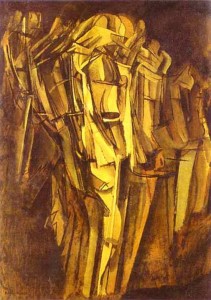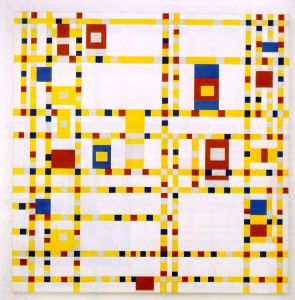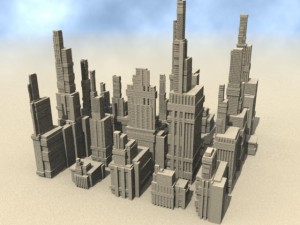About ten years ago I was asked to write a book. It was the first time somebody asked me to do this. The person who asked me to write a book was the former director of a foundation called SMO, Wim de Ridder. SMO is a Dutch think tank paid by many big companies in the Netherlands.
Together with Wim de Ridder, Erik Vreedenburgh and Gerard Rijntjes a team was formed. We wanted to explore a concept called Open Form.
Open Form uses the principles of evolution. We organized the book as a process. We started to interview many scientists and artists about evolution and created an interaction between them. People in isolated field of science got together and created new combinations. The book was a picture of a certain state of the process but the process went on after the “book” was published.
Konstapel. J. Vreedenburgh E, Rijntjes G.J.P. De onvermijdelijke culturele revolutie. Den Haag, SMO, 1998.
Open Form became the method SMO wanted to use and the first project was a big one. Big companies in the “Stimulant” Industry like Heineken wanted to start a dialog with the Dutch Government about the prevention of addiction. They gave us a budget to explore an innovative approach. The new approach was based on the theory of Roger Schank. Roger was a friend of mine and he was asked to become an advisor. He adressed the so called Les Indes Meeting in the Hague and the participants were so impressed that they gave us a budget.
What we wanted to build was a game and the inputs of the game were “real life stories”. The story of the project is told in this book “Virtueel Genieten. Diekstra, Drs. J. Konstapel, J.G. van der Leij, Prof.Dr. J.B. Rijsman, Drs. M.A. Visse, K.B. Vos, Drs. N. van Geelen”.
The game was a success. It was such a success that many government paid institutions started to block the implementation of the game. They were producing brochures and employed many researchers. The blocking of the implementation was successful. Strangely enough the researchers never paid any attention at the theory of Roger Schank. Sadly enough they have not done this until now. Researchers always want to re-invent the wheel.
Later a new tool was developed to support people that were un-employed and mentally ill (Virtual Work). The story of the project can be found in this book INTERNETSTURING IN DE ZELFREDZAME SAMENLEVING, Prof.dr. J.B. Rijsman, Drs. N. van Geelen, Drs. T.J. Golder.
We still used the theory of Roger Schank but combined his theory with the theory of Will McWhinney. The same thing that happened with our former project happened again. The government agency that was paying for the tool was unable to use it. Until now they are unable to help people to find suitable work. The main reason is that they are blocking every innovative action of a person who wants to start all over again. There are many rules that prevent this.
The next project was called Time Out. The target of this project was to build the most advanced story-telling-engine ever made. All the experience we had gathered in the former project would be used and the budget was spectacular. Unfortunately the project was never started. SMO decided to do it their own way. This is the game they created: http://www.mazzle.nl/.
This is the book they wrote about the project. MAZZLE, Nieuw perspectief op gezondheidsvoorlichting, Jeroen Duijvestijn.
Have a look at our project plan (Dutch).
It this project we also used the theory of Emotions of Nico Frijda and Interpersonal Theory.
Many people are now developing story-based websites but developing an effective story based game is something (I think) almost nobody has accomplished.
I will give you a two hints why all of them will fail.
The first thing is the collection of stories. Many people are telling stories but after a some time you realize that 80% of the people are telling the same story all over again. They are the victims. When you want to motivate people to “change their lives” stories about how people are not changing their lives are not helpful. This is also the problem with many self-help-cites. Victims always find places where they find other victims. The victims are entrained by the stories of the other victims. Nothing changes.
So when you want to find people that were successful you have to look elsewhere. This was the real problem with the project Virtual Work. The Dutch Government Agency that is taking care of the unemployed UWV , was unable to provide us with people with a success story. We used our own network to find them and they were rare.
The second problem is the Interview itself. You need a special gift to get the right story out of people. This gift is called empathy. You also need to know all the stories that are already told to know when the real important facts are “coming”.
Have A Look at this PowerPoint Presentation.
LINKS
My article in the book “De onvermijdelijke culturele revolutie” (in Dutch)
The book about the project “Virtueel Genieten” (in Dutch)
 Since 1915,
Since 1915,  This is what Mondriaan wanted to achieve “Our material environment can only posses a pure beauty (i.e., be healthy and satisfy utility in a truly direct way), if it no longer reflects the egoistic feelings of our small personality: it does not even have any lyrical expression any more, but is purely plastic.”
This is what Mondriaan wanted to achieve “Our material environment can only posses a pure beauty (i.e., be healthy and satisfy utility in a truly direct way), if it no longer reflects the egoistic feelings of our small personality: it does not even have any lyrical expression any more, but is purely plastic.”  I have been involved in many experiments in this area. I worked with
I have been involved in many experiments in this area. I worked with 